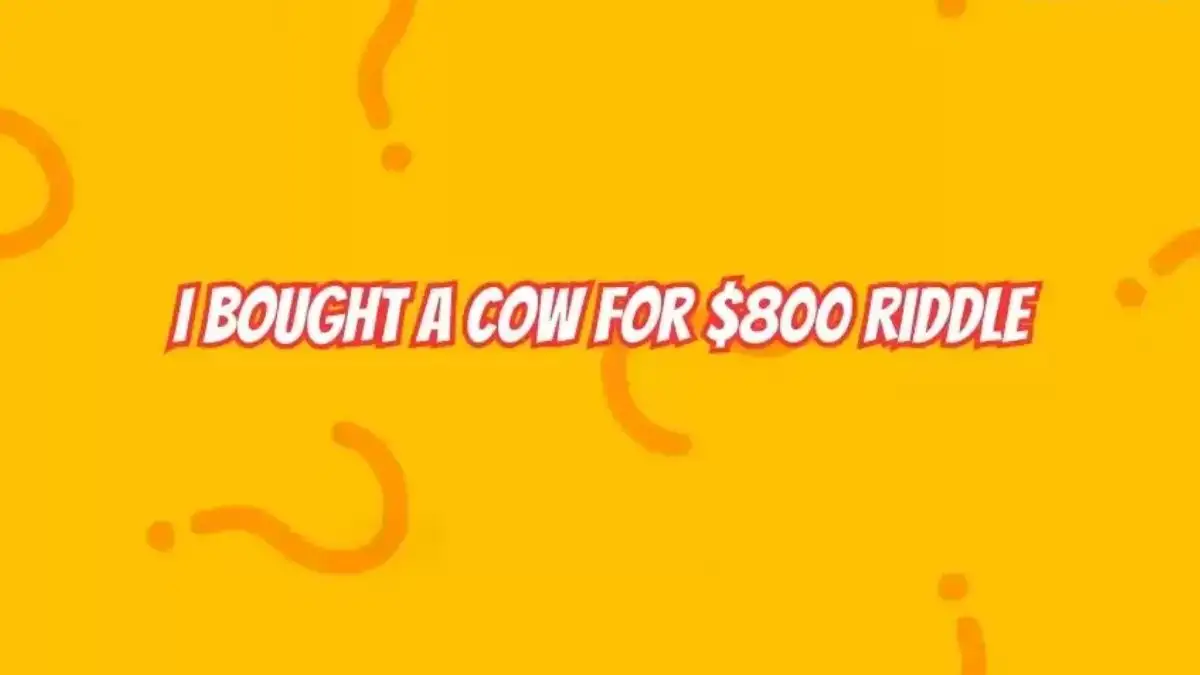I Bought a Cow for $800 Riddle Answer Explained
by Abinaya
Updated Nov 17, 2023

I Bought a Cow for $800 Riddle
When faced with the I Bought A Cow For $800 Riddle, your mind naturally generates numerous potential solutions. You find yourself engaging in a brainstorming process to unravel the answer to this intriguing riddle. Typically, when confronted with a riddle, the desire to uncover its solution often surpasses that of other inquiries due to the clever and captivating responses it offers.
Here is the complete question from the I Bought A Cow For $800 Riddle.
"I Bought A Cow For $800.
I sold it for $1000.
I bought it again for $1100.
I sold it again for $1300 Dollars.
How Much Did I Earn?"
I Bought a Cow for $800 Riddle Answer
The riddle "I bought a cow for $800, sold it for $1000, bought it again for $1100, and sold it again for $1300. How much money did I make?" is a trick question
The answer is $400.
Many people make the mistake of adding up the profits from each sale and subtracting the cost of the cow, which would give an answer of $500. However, this double-counts the cost of the cow, since it is both bought and sold twice. To get the correct answer, we need to subtract the cost of the cow from the final sale price, and then subtract the cost of the cow from the profits from the first sale. This gives us:
$1300 - $800 - $800 = $400
Therefore, the total profit made is $400.
This riddle is a good reminder to be careful when calculating profits and losses and to make sure that we are not double-counting anything.
I Bought a Cow for $800 Riddle Explanation
The riddle "I bought a cow for $800, sold it for $1000, bought it again for $1100, and sold it again for $1300. How much money did I make?" is a trick question because it asks you to calculate your profit over four transactions, but you only actually make a profit on two of those transactions. The key to solving this riddle is to realize that you are buying and selling the same cow each time.
So, when you buy the cow for $800 and then sell it for $1000, you make a profit of $200. But then you buy the cow back for $1100, which cancels out $100 of your profit. When you sell the cow again for $1300, you make another profit of $200. But again, you have to subtract the cost of buying the cow back, which was $1100.
So, in total, you make a profit of $400. Here is a breakdown of the four transactions:
Buy cow for $800
Sell cow for $1000 (+$200 profit)
Buy cow back for $1100 (-$100 profit)
Sell cow again for $1300 (+$200 profit)
Total profit: $400
What are Riddles?
Riddles are a form of word puzzle or brainteaser that typically presents a question, statement, or description with a hidden or double meaning. They challenge the reader or listener to think critically and creatively in order to decipher the intended solution. Riddles have been a part of human culture for centuries, used for entertainment, intellectual exercise, and even as a form of folklore. Here are some key aspects and characteristics of riddles:
I Bought a Cow for $800 Riddle - FAQs
The "I Bought a Cow for $800 Riddle" is an intriguing puzzle that challenges individuals to calculate their earnings from a series of cow transactions. It has gained popularity for its clever and entertaining nature.
The answer to the riddle is $400. While it appears to involve multiple transactions, the key to solving it is recognizing that you are buying and selling the same cow each time, leading to a total profit of $400.
Riddles are word puzzles that often contain hidden meanings or clever language, challenging individuals to think critically and creatively to decipher the solution. They have a rich cultural history and come in various forms, engaging the mind and encouraging problem-solving.
Riddles are popular for their entertainment value and ability to engage the mind. They have been used in literature, folklore, and educational contexts, providing enjoyment and enhancing cognitive skills.
You can find a wide variety of riddles, including similar puzzles, on the internet and in books dedicated to riddles and brain teasers. They are often used in games and educational activities to entertain and challenge participants.







